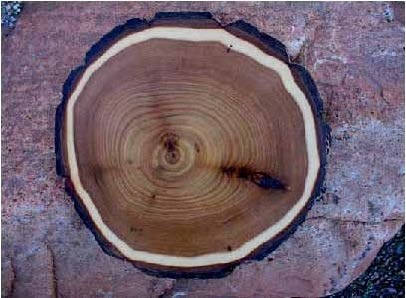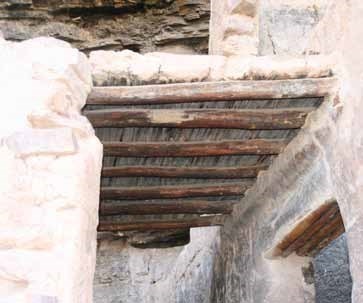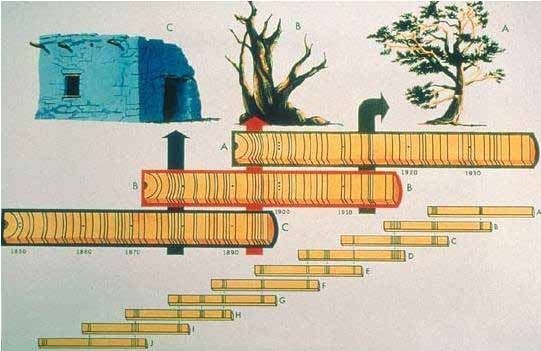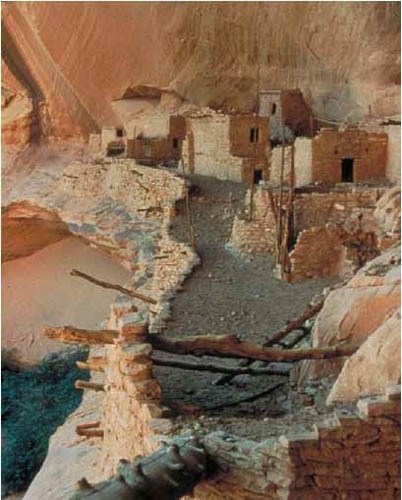
What is Dendrochronology?Around the Upper and Lower Cliff Dwellings, small, numbered plugs dot pieces of wood. These plugs mark the spot where researchers have taken a core sample to try to determine the age of the wood by examining its tree rings. Scientists do this by comparing the tree-ring pattern of samples with unknown dates to known samples from the same geographical area. If they can find a match, then the unknown sample can be dated, providing archeological information. Tree-ring dating is also called dendrochronology. Dendrochronology, or tree-ring dating, is the science that assigns accurate calendar dates to the yearly growth rings produced by trees (Nash 2000). Archeologists have used this accurate and sophisticated dating method for nearly a century. Archeological sites in the American Southwest were the proving ground for this method, which refined our understanding of the development and decline of past peoples. Events such as volcanic eruptions, earthquakes, forest fires, and insect infestations can also be understood through the use of tree-ring dating. Dendrochronology can show us more than just the age of trees. It can also give us a glimpse into past climatic conditions. In temperate zones, one year of growth will equal one tree ring. A wet growing season makes a wider ring, while a dry growing season makes a narrower ring. In addition to recording the amount of moisture, tree rings also reflect other climatic factors, such as temperature and cloud cover, since those factors also affect tree growth. This information can help us understand what kind of climatic conditions the Salado people experienced when the dwellings were occupied. Who Invented Dendrochronology?Andrew Ellicott Douglass and Clark Wissler were the first to apply tree-ring dating in archeology. Douglass was an astronomer at Lowell Observatory in Flagstaff, AZ in the early 1900s (Dean 1997). He established the basics of tree-ring dating while studying the earth’s climate in relation to sunspot activity. Douglass discovered that different trees had identical growth ring patterns that could act as climatic records for use within his research (Dean 1997). By 1914, Douglass had established a 500-year chronology for the Flagstaff region (Bannister and Robinson 1975). An acquaintance, Clark Wissler of the American Museum of Natural History in New York City, knew of Douglass’ dendrochronological series and thought the process could be used to date archeological sites. Wissler sent Douglass prehistoric wood sections from archeological sites in New Mexico to cross-date with his existing chronology. Dendrochronology’s Prominent FiguresAdapted from Dean (2009) “Trees, Time, and Environment” Other prominent figures in the development of dendrochronology include Harold S. Colton, co-founder of the Museum of Northern Arizona (MNA), Lyndon L. Hargrave, Field Director at MNA and Emil W. Haury, of the University of Arizona who confirmed Douglass’ master chronology. Colton was the person who directed Douglass to ideal wood sources for tree-ring dating from archeological sites. Colton also assisted Douglass in the search for the missing segment that connected the relative dates from other sites in the Southwest. Hargrave helped to establish the archeological chronology of the Flagstaff area by directing various archeological projects where numerous tree-ring samples were collected. With Haury’s confirmation of the master chronology, the Southwest archeological community more easily accepted dendrochronology as an important method for obtaining accurate calendar dates of archeological sites. This communal acceptance led to the development of many local archeological dating sequences within the region. 
Applying Dendrochronology to Archeological SitesIn 1920, Douglass applied relative, not precise, dates to Aztec Ruin outside of Farmington, NM and Pueblo Bonito at Chaco Canyon using tree-ring dating. He reported the relative dates of these sites in Natural History magazine in 1921 (Bannister and Robinson 1975; Nash 2000). By 1929, long historic and prehistoric tree-ring chronologies existed, but they were not continuous. In the same year, Douglass connected the two tree-ring chronologies from a beam found at Whipple Ruin in Show Low, AZ thereby revealing the first accurate dates for many sites in the Southwest (Downum 1999; Nash 2000). During this time, archeologists also began to associate tree-ring dates with ceramic styles (Dean 2009), allowing them to make correlations between certain tree-ring dated sites and the variety of designs on pots or potsherds at sites. 
How Does Dendrochronology Work?Archeologists use tree-ring dating to understand past human chronological, behavioral, and environmental events and conditions. Tree-ring dating can be performed on woody plants that produce recognizable and unique tree rings during a single growth season (Ahlstrom and Smiley 1998). However, conifers often yield the most accurate readings because their growth is sensitive to climatic and environmental changes. Dendrochronology is performed by finding identical sequential tree-ring patterns among many different trees (Dean 2009). A yearly incremental interval scale is used to measure these rings. Each interval is marked by the start of one tree growth season to the beginning of the next (Ahlstrom and Smiley 1998). How Does Climate Affect Tree Rings?Regional climatic irregularities produce tree rings of various sizes that can be cross-dated, or compared, to many other specimens that have identical or overlapping patterns. Trees grown in a more temperate climate tend to produce uniform tree rings that are inadequate for precise tree-ring dating. For example, a tree beside a river will likely consume similar amounts of water during each growth season. Therefore, large, uniform rings with little variation are produced. 
including living trees, to extend the timeline and to assign rings to the year they formed. Analyzing Tree Rings in a LaboratoryFor archeological purposes, tree-ring samples can be analyzed three ways: chronological analysis, behavioral analysis, or climatic analysis. Chronological analysis involves studying tree-ring core samples taken from structures such as pit-houses, pueblos, and cabins. This process places these sites into a time sequence defined by archeologists for a certain geographic area. Archeologists strive to recover tree-ring cross-sections that contain bark, or the final growth rings. The outermost tree ring of a prehistoric specimen signifies the death date of the tree. However, an archeological event does not always coincide with the death of the tree. The tree may have died many years before it was cut and used. Archeologists must understand the context of the site and rely on the strength of the tree-ring dates obtained from core samples to effectively date a site or event. Behavioral analysis is an important component for obtaining information on past human behavior. The archeologist can use behavioral analysis to determine how humans used trees as natural resources and how the wood was used as a raw material during each archeological period or event (Dean 1997). For example, some past people traveled many miles to reach stands of a certain type of tree such as pinyon pine or Douglas fir. Other groups chose to reuse older beams in abandoned sites or to use large driftwood logs near their sites. Knowing how trees were cut and processed for construction provides clues to past human behavior. Climatic analysis involves studying environmental conditions that generate the variations observed among the tree rings. From these variations, archeologists can reconstruct past climate conditions. For example, dendroclimatology uses tree-ring widths to reconstruct past environmental conditions and changes (Dean 2009). Droughts, floods, precipitation, and temperature are among the climate-related conditions that can be observed in tree-rings (Dean 2009). Understanding past environmental and climatic conditions provides insights into the various factors that cause change or stability within past human cultures (Dean 2009). Dendrochronology is also used to adjust radiocarbon dates due to variations within the radiocarbon content in the earth’s atmosphere and water sources over time (Ahlstrom and Smiley 1998). 
throughout the American Southwest, such as Keet Seel in Navajo National Monument, AZ. Literature CitedAhlstrom, Richard V.N., and Francis E. Smiley. 1998. Perspectives on Chronometric Dating with Radiocarbon and Tree-Rings. Archaeological Chronometry: Radiocarbon and Tree-Ring Models and Applications from Black Mesa, Arizona, edited by F.E. Smiley and R.V.N. Ahlstrom, pp 3-12. Occasional Paper No. 16. Southern Illinois University at Carbondale Center for Archaeological Investigations. Bannister, Bryan, and William J. Robinson. 1975. Tree-Ring Dating in Archaeology. World Archaeology 7(2):210-225. Dean, Jeffrey S. 1997. Dendrochronology, in Chronometric Dating in Archaeology - Advances in Archaeological and Museum Science, edited by R.E. Taylor and M.J. Aitken, pp 31-64. Birkhäuser, Boston. Dean, Jeffrey S. 2009. Trees, Time, and Environment. Unpublished manuscript. Downum, Christian E. 1993. Southwestern Archaeology: Past, Present and Future. Expedition 35(1):4-13. Nash, Stephen E. 2000 Seven Decades of Archaeological Tree-Ring Dating. In It’s About Time: A History of Archaeological Dating in North America, edited by S.E. Nash, pp 60-82. University of Utah Press, Salt Lake City. More on Dendrochronology at Tonto National Monument |
Last updated: June 3, 2022
